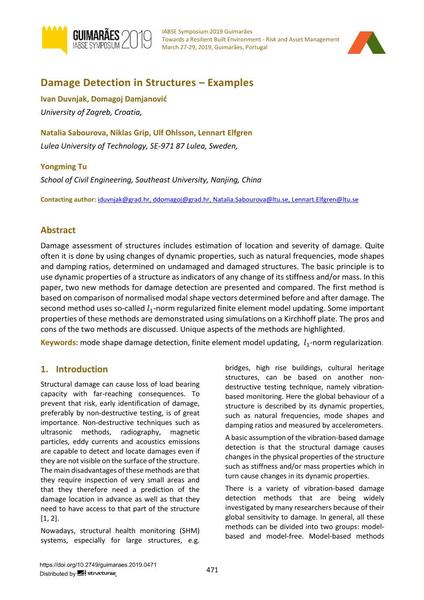Damage Detection in Structures – Examples

|
|
|||||||||||
Détails bibliographiques
| Auteur(s): |
Ivan Duvnjak
(University of Zagreb, Croatia,)
Domagoj Damjanović (University of Zagreb, Croatia,) Natalia Sabourova (Lulea University of Technology, SE-971 87 Lulea, Sweden,) Niklas Grip (Lulea University of Technology, SE-971 87 Lulea, Sweden,) Ulf Ohlsson (Lulea University of Technology, SE-971 87 Lulea, Sweden,) Lennart Elfgren Yongming Tu (School of Civil Engineering, Southeast University, Nanjing, China) |
||||
|---|---|---|---|---|---|
| Médium: | papier de conférence | ||||
| Langue(s): | anglais | ||||
| Conférence: | IABSE Symposium: Towards a Resilient Built Environment Risk and Asset Management, Guimarães, Portugal, 27-29 March 2019 | ||||
| Publié dans: | IABSE Symposium Guimarães 2019 | ||||
|
|||||
| Page(s): | 471-478 | ||||
| Nombre total de pages (du PDF): | 8 | ||||
| DOI: | 10.2749/guimaraes.2019.0471 | ||||
| Abstrait: |
Damage assessment of structures includes estimation of location and severity of damage. Quite often it is done by using changes of dynamic properties, such as natural frequencies, mode shapes and damping ratios, determined on undamaged and damaged structures. The basic principle is to use dynamic properties of a structure as indicators of any change of its stiffness and/or mass. In this paper, two new methods for damage detection are presented and compared. The first method is based on comparison of normalised modal shape vectors determined before and after damage. The second method uses so-called 𝑙l-norm regularized finite element model updating. Some important properties of these methods are demonstrated using simulations on a Kirchhoff plate. The pros and cons of the two methods are discussed. Unique aspects of the methods are highlighted. |
||||
